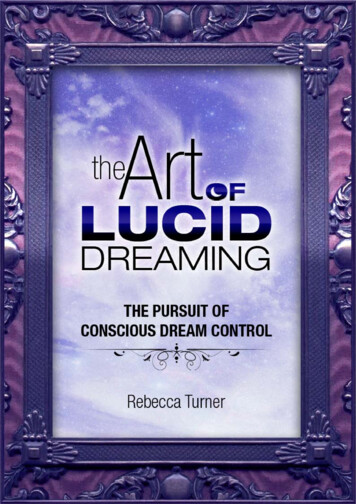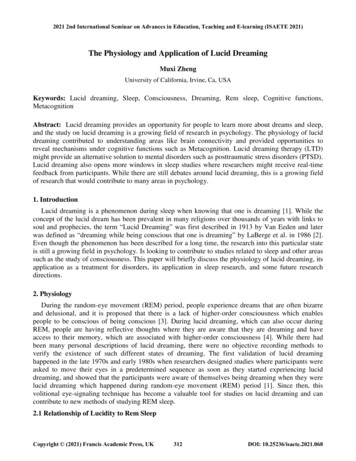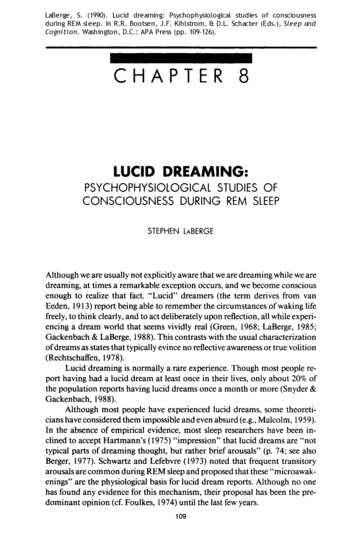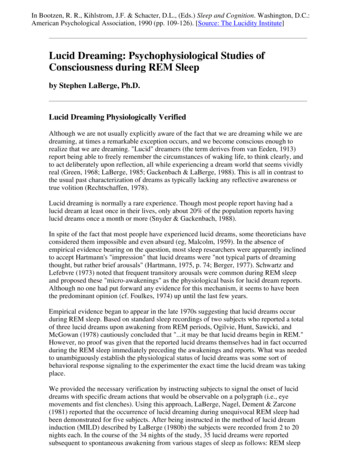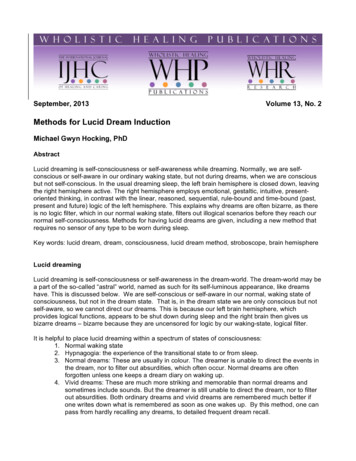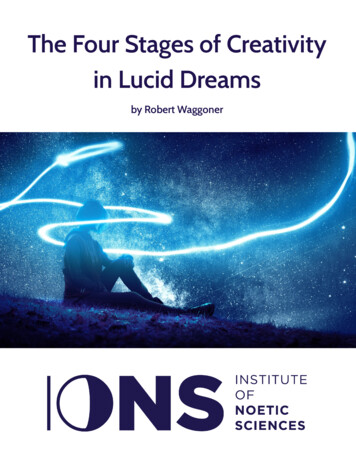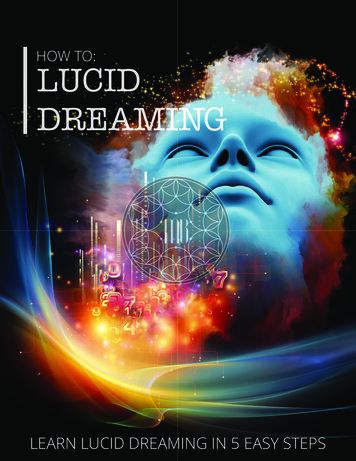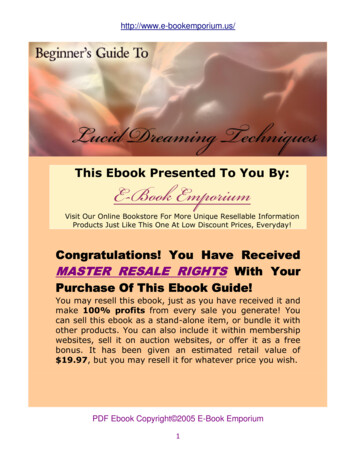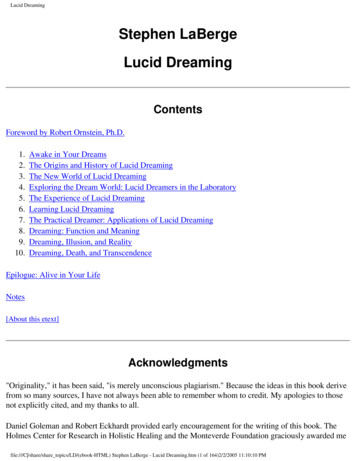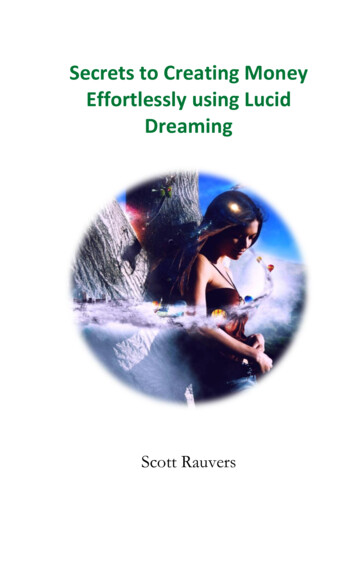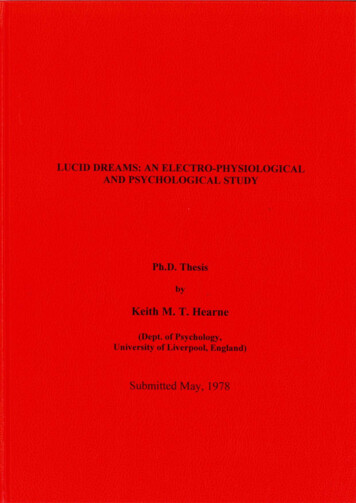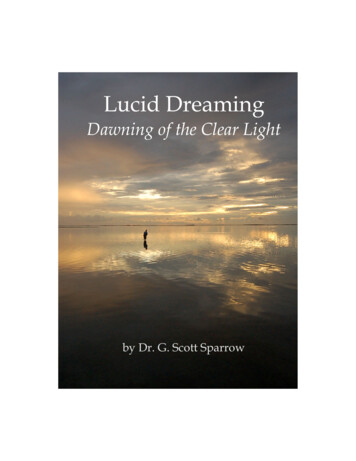
Transcription
Lucid DreamingDawning of the Clear Lightby Dr. G. Scott Sparrow
Lucid Dreaming: Dawning of the Clear LightBy G. Scott SparrowAll Rights ReservedDr. Scott Sparrow 1972 – 2010 Lucid Dreaming: Dawning of the Clear Light2
Dr. G. Scott SparrowI have been working with dreams since I was a teenager. When Iwas 19, I had the first of countless lucid dreams, many of whichhave culminated in the experience of white light. A couple ofyears later, I did my master’s thesis on lucid dreaming as anevolutionary process, which compares Jungian principals on thedevelopment of consciousness in the primitive world to thearousal of lucidity in the dream state.Shortly thereafter, I wrote Lucid Dreaming: Dawning of the Clear LIght (A.R.E., 1976), whichwas the first book on lucid dreaming in North America. In 1983, I completed a doctoraldissertation at William and Mary on using “dream reliving” as a lucid dream induction strategy. Ihave also explored middle-of-the-night meditation as a lucid dream induction strategy, andbelieve it’s one of the best ways to enhance the overall quality and depth of our dreams.After becoming licensed as a psychotherapist in 1982, I began to apply the principles ofcocreative dream theory–or the idea that dreams need to be seen as an interactive encounterbetween dreamer and dream imagery–to the analysis of nonlucid dreams, and subsequentlydeveloped the FiveStar Method. I have just coauthored a paper on this method (J. of Creativity inMental Health, in press), and I’m currently working on a book on the FSM and co-creativedream theory.As a professor, I incorporate dream work training into my graduate counseling courses, and as atherapist, I work with the dreams of virtually every client of mine. I have recently foundedDreamStar Institute, which offers certification in dream analysis. Also, I am currently involvedin conducting a PTSD study that that will explore dream reliving and middle-of-the-nightmeditation as a treatment for distressing nightmares. I have written several books on religiousexperiences, and recently published a memoir titled, Healing the Fisher King: A Fly Fisher’sGrail Quest, which is an account of how dreams ushered me through a life-threatening midlifeordeal.For more information:http://www.spiritualmentoring.com/ and http://www.dreamanalysistraining.comDr. Scott Sparrow 1972 – 2010 Lucid Dreaming: Dawning of the Clear Light3
Chapter One: A Personal Account“ Its light gleams like oil tonight when I am aloneOn the last night, also will it shine.”--Octavio PazLucid dreaming, or the experience of becoming conscious while in the dream state, firstcame to my attention in a dream early in 1972. Like many persons who have had such anexperience, I was deeply impressed with its significance. The dream had such an effect thatit seemed to change the direction of my life at the time. It continues to be a source ofstrength even now. It is as follows:“It seems that I have come home from school. I become aware that I’m dreaming as I standoutside a small building which has large black double-doors on its eastern side. I approachthem to enter. As soon as I open them, a brilliant white light hits me in the face.Immediately I am filled with intense feelings of love.“I say several times, ‘This can’t be a dream!’ The interior resembles a small chapel ormeeting room. It has large windows overlooking barren land like the Great Plains. I think tomyself that this is somehow real in a three-dimensional sense. Everything is amazinglyclear and the colors brilliant.“No one is with me, yet I feel that someone needs to be there to explain the sense ofpurpose that seems to permeate the atmosphere.“At one point I walk holding a crystal rod (or wand) upon which a spinning crystal circlet ispoised. The light passes through it and is beautiful.” (Sparrow, 1972)Upon awakening, I lay quietly in my bed and felt bewildered. Why had this experience beengiven to me? What I had done to deserve it? Although these questions proved to beunanswerable, I did recall a significant experience the previous day that seemed at the timeto relate directly to the dream.I had embarked on a two-hundred-mile trip to attend my brother’s graduation from AirForce flight school. I planned to stay the night and return home the next day. As I drovethrough the rocky plains of central west Texas towards Del Rio and the distant Mexicanmountains, I suddenly realized that what I was doing was for the love of my brother. I washumbled by the realization that such pure acts of love had been rare in my life. For a longwhile afterward, I dwelt in this feeling and watched the sun gently sink behind theDr. Scott Sparrow 1972 – 2010 Lucid Dreaming: Dawning of the Clear Light4
mountains over Mexico. The play of light upon the stark landscape kept awake the feelingof love within me.Since this first lucid dream, I have noticed on sevseveraleral occasions that lucidity has arisenfollowing an experience of love or deep rapport with another person. Sometimes when Iexperience this kind of contact during the day, I am able to sense that a lucid dream isimminent. On these days, I try to retire earlier than usual to allow the experience time tounfold.After my first lucid dream it was months beforeconsciousness again emerged in my dreams. Ihad not begun to cultivate the faculty or toattribute any particular significance to it, in andof itself.elf. Yet the memory of the Light and theluminous feelings associated with it left me withan intense desire to re-experience itstransforming effects.Meditation and dreamwork became a part of mydaily regimen soon after this first lucid dream.About sixx months later, after meditating onenight with a girl friend, I had a strong feeling thatan important experience was awaiting me insleep. After sharing the impression with her, Isaid good night earlier than usual and wenthome. Before going to sleep I moved my bed so that I would be able to see the stars throughmy bedroom window. This ritual seemed to enhance the feeling of expectancy. I went tosleep and had the following experience in the early morning:“I feel that I am waking up. I realize that I’I’ve been hashinging through many ideas andproblems. As I lie in my bed with my eyes closed, I suddenly realize that there is no reasonwhy I shouldn’t experience the Light! I feel a complete lack of the usual feelings ofunworthiness. It’s as if a problem hahas been solved by the long period of self-reflection.reflection.“As I wait expectantly, a warmth begins to fill my body. Although my eyes are closed, Isense that a white light is shining through the window and entering my solar plexus. Itrushes upward until a warm brightness fills my vision. I feel deep love and surrender, andwish that some of my friends could experience this also.“After the Light subsides, I bound out of bed and go searching about the house for theMaster who made the experience possible. I seseee no one. Then I awaken.” (Sparrow, 1972)Dr. Scott Sparrow 1972 – 2010 Lucid Dreaming: Dawning of the Clear Light5
Since I was not aware at the time that I was dreaming, this experience cannot beconsidered by definition a lucid dream. Yet because the relationship between the Light andthe awakening of lucidity has been so pronounced in subsequent dreams, I feel that thisexperience should be included to provide a comprehensive picture of the development oflucid dreaming.Also, the dream reveals a common characteristic of many “prelucid” dreams -- a “false”awakening. This is when the dreamer thinks he is awakening from sleep only to discoverlater upon actual awakening that he was still dreaming. Sometimes lucidity occurs after thefalse awakening -- when the dreamer finds himself in another place or in unfamiliarsurroundings. Thus, although the false awakening does not necessarily result in the arousalof lucidity, it seems to represent a growth in that direction.When lucidity began to arise with increasing regularity in the following months, I soonnoticed that it emerged predictably after a deep or fulfilling meditation. It became clearthat when my devotional life was intense, lucid dreams would arise as a concomitant. Thisrelationship became more pronounced when I began meditating for fifteen or twentyminutes during the early morning hours (from 2:00 to 5:00 a.m.). As I would return tosleep, dreams of amazing clarity as well as brief periods of lucidity would occasionallyensue. I have often thought that if a person would diligently practice meditation in the earlymorning hours for the purpose of attunement, lucid dreams would be the natural result.Except for rare occasions when I have passed into a lucid dream without a break inconsciousness, most of my lucid experiences have begun with a “normal” dream. As thedream progresses, something unusual happens to convince me that I am dreaming. Thesituations in the dream that have provoked lucidity with the greatest frequency are of twobasic interrelated types. The first and perhaps most common stimulus is when I amconfronted with a threatening person, animal or situation. In this type of dream the desireto escape usually results in aborting the stressful dream. On some occasions, the stress isalleviated through the arousal of lucidity. In this case, the dreamer catapults into greaterawareness out of apparent necessity. The fear itself seems to encourage the development oflucidity as a coping mechanism which enables a creative interaction between the dreamerand the frightening situation. Undoubtedly, the resolution of such dreams can have aprofound healing effect in the dreamer’s waking life, as well.An example of this type of lucid dream is as follows:“I am being pursued in the area of my freshman residence by a group of men. As I runfearfully through the neighborhood, dodging in between houses, I become aware that I amdreaming and that the fear is unnecessary. I realize that I have a choice to go to meet mypursuers or to meditate. I feel a need to return and work through the conflict. So I try to flyDr. Scott Sparrow 1972 – 2010 Lucid Dreaming: Dawning of the Clear Light6
to the area where they are located. I will myself upward until I am high above the earth. Butbefore I get to the place, a pleasant vibration courses through my body, and I awaken.”(Sparrow, 1974)This dream and others of a similar nature reveal a very important principle of luciddreaming, especially as it relates to the confrontation of fear or problems. The principle is:Once lucidity arises the dreamer may actually release himself from confronting a problemon its own level. In the above dream I chose rather to return to confront my attackers toreconcile the conflict. This, of course, may be valuable and necessary at times, and leavesthe dreamer with an exhilarating sense of having overcome a fearful situation. Lucidityseems to be a fragile faculty, however, particularly during the beginning stages. It can bequickly submerged by feelings of overconfidence, as is suggested in the above dream.A strong case can be made for the need to regard lucidity as an opportunity to cooperatewith or forgive the dream elements rather than an opportunity to exercise control overthem. The importance of this approach is evident when we regard the dream as having twodiscrete parts -- the symbolic content, and the dreamer’s response to it.Since we possess a limited understanding of the workings of the unconscious, we might dowell to approach it with an attitude of healthy respect. Whenever we speak of changing thedream content according to our momentary desires, we are opening the possibility ofviolating the organic integrity of our unconscious, inner natures. Yet this risk does notrender lucid dreaming necessarily destructive. On the contrary, the lucid dream presents aunique opportunity to alter and improve one’s responses in the dream that can therebyfacilitate a creative and growing relationship to the dream content.As lucid dreaming is becoming more widely known in popular literature, it is unfortunatethere is such an emphasis upon the manipulative capacity of the dreamer. Such anapproach to this potentially powerful experience is likely to replicate man’s regrettable“master-slave” relationship to nature and the physical world, and only lead to a false senseof triumph.Another situation that has apparently stimulated lucidity in my case has been thepresentation of a novel or incongruous element within the dream. These anomalies can beobserved in normal dreams as well, but are overlooked with regularity. For example, suchincongruous events like a familiar person who looks different; a familiar scene that revealsan obvious flaw, or an event that violates known physical laws.The following two dreams illustrate this type of lucid dream:“I go to visit Ann whom I haven’t seen for months. When I enter her office, she seems veryaloof which is unlike her. Also, her face looks different. I realize that it isn’t she at all andDr. Scott Sparrow 1972 – 2010 Lucid Dreaming: Dawning of the Clear Light7
that I am dreaming. Immediately I drop to the floor and begin meditating. I awaken soonafterward.”“I am on a high hill above a lake, searching for Indian artifacts. It seems that I am being toldabout the culture which existed in the area during primitive times. I am told that theIndians were very advanced in the art of stone flaking (i.e., tool making).I go on top of thehill and find three beautifully crafted stone trowels or knives. I realize that they are too fineto be real, and I must be dreaming. “Taking the stone trowels, I sit down to meditate facingeast and stick the trowels in the ground, one at a time. I repeat, ‘The Father, the Son, theHoly Ghost.’“At this point Alta walks by. I ask ‘Do you know that we are dreaming?’ She laughs. So Ipoint out the three stone objects on the ground. In their midst items of silverware beginspontaneously to appear—first a fork, then a cup. I look at her face. She is puzzled,seemingly on the verge of ‘waking up.’ I take the items away and other objects appear. Webegin to laugh as the process speeds up. We are inundated with beautiful silver objects.Then I awaken.” (Sparrow, 1974)This type of lucid dream resembles the first except that the anomaly or inconsistent eventin the dream lacks a threatening quality. The dream is merely at variance to what thedreamer knows to be true or possible. Oliver Fox calls this distinguishing awareness, whichbegins to arise with greater frequency once it occurs, the “critical faculty.” This awarenessis essentially the recognition of inconsistency. The development of such a faculty hasconstructive but painful implications for the waking state. If through the development ofthis “critical faculty” we are able to attune ourselves to every inconsistency in our attitudesand actions, we have surely begun to traverse the difficult path to self-understanding. Itmay even be possible that lucidity occurs to the degree one is able to recognizeinconsistency during the waking state. It is probable that as we work with lucid dreamingwe will also begin to meet daily problematical opportunities that encourage and evenrequire the extension of the qualities of lucidity into our waking life. We can expect tobecome more objective and unattached, as well as more cognizant of the purpose behindour immediate experiences.The following quotation is from Carl Jung in his commentary on The Secret of the GoldenFlower:“The way is not without danger. Everything good is costly, and the development of thepersonality is one of the most costly of all things. It is a question of yea-saying to oneself, oftaking oneself to the most serious of tasks, of being conscious of everything one does, andkeeping it constantly before one’s eyes in all dubious aspects -- truly a task that taxes us toDr. Scott Sparrow 1972 – 2010 Lucid Dreaming: Dawning of the Clear Light8
the utmost.” (Wilhelm, pp. 95)Since the inception of lucidity into my dream life, the lucid dream has clearly evolved in aspecific direction -- toward a closer relationship to the inner Light. Many times has itpresented itself, but rarely have I received it fully. I have begun to regard lucidity as aplatform within the dream upon which I can become receptive to this Light.During the first lucid dreams, I was not aware of this opportunity. But gradually, a lightbegan to appear in my dreams which at first I mistook for a bright star, the moon or thesun. Usually bright white in color, it would suddenly appear hovering above me andincreasing in intensity. One of the first such dreams is as follows:“I am thinking or reading something about earthquakes. A friend calls me to a window (inan unfamiliar house) and excitedly says, ‘the sun has a blue flake on it!’“I look out the window. A white sun is about 30 above the northern horizon. I notice that ithas a bluish tint to it, but think that’s probably due to a retinal afterimage. I think, ‘If I amdreaming, then that is the Light, not the sun!’ In order to test this, I try to enter into ameditative state. But then I decide that I’m not dreaming, though the sun has increased insize.” (Sparrow 1974)As a result of such dreams, I soon decided that whenever I became lucid in a dream, I wouldpray for the Light and seek to enter a meditative state. I have since found that failure to doso usually results in premature awakening or in being eventually distracted by the dreamenvironment to the extent of being reabsorbed in the normal dream consciousness.The practice of prayer and meditation in the dream has allowed me to focus attention onwhat I truly desire to encounter without being distracted by the unlimited possibilitieswhich may arise in the lucid dream. Prayer and meditation have seemed to consolidatewhat can be a fleeting experience. Yet more important, the attitude of receptivityengendered by this practice has invited -- in the case of many dreams -- an immediatepresentation of the Light.I was amazed to discover the practice of seeking the Light through the lucid dream isdescribed in ancient Tibetan manuscripts, particularly in the writings that were translatedby Evans-Wentz and published as Tibetan Yoga and Secret Doctrines (Evans-Wentz, 1958).In the chapter entitled “The Doctrine of the Dream State," the adept is admonished tobecome aware of the illusory nature of the dream images while in the dream! There arevarious physical and mental exercises given to enable the adept to achieve lucidity. One ofthe goals of this process is to carry the waking consciousness into the dream and vice versawithout a break in consciousness.Dr. Scott Sparrow 1972 – 2010 Lucid Dreaming: Dawning of the Clear Light9
The primary purpose for establishing this continuity of consciousness is to allow thedreamer to begin to realize that the environment of the waking state is a selfself-createdcreateddream as well. This recognition leads the adept to the second and most important phase ofthe lucid dream which is meditating on the Reality behind the dream images. This stage ofthe lucid dream during which the dreamer may enter an illuminated state is referred to inthe Tibetan text as the “Dawning of the Clear LiLight.”ght.” It is a stage in which the dreamer turnshis attention to the Source motivating the dream images.For some reason an individual seems to become more accessible to illuminatory experiencewhen actually meditating in the dream state than in the wakinwakingg state. It is as if the barrierbetween the person and the Divine becomes transparent, revealing the Luminosity whichhas been so effectively obscured by unfulfilled experiences, guilt, and reprehensiblethoughts. As the desires and fears inherent in this subconscious barrier are forgiven oraccepted, the dreamer then may come faceface- to-face with the Divine.I have found that when the Light makes its appearance in the lucid dream, the precedingevents usually fall to the wayside. Whereas the initial dreamm may have been an importantpreliminary experience, the presentation of the Light seems to represent the essentialculmination of the dream process. The dreamer has thus far accrued a great deal ofindependence and response capability which has accompanieaccompaniedd the emergence of lucidity.Yet as the Light becomes visible, the dreamer realizes that the independence and theinterests of self must be relinquished if the Light is to approach and become an innerexperience. The preeminent demand placed upon the dreadreamermer as he stands at thisthreshold is to surrender.I have found this to be an extremely difficult thing to do. The difficulty is illustrated in thefollowing dream:“I am outdoors and see a light in the sky. I am toldthat I must turn my head away if the light is todescend upon me. I am aware that I am dreaming. Ibow my head. The ground around me becomesilluminated by the brilliant orb. I begin to be afraidas it nears me. I look up, and it withdraws into thesky. The process is repeated, but I fail to overcomemy fear. I awaken.” (Sparrow, 1974)Usually when I desire the illuminatory experience, Ifail to realize that I am asking for a supremelyhumbling experience. This is easy to forget when my thoughts turn to the beauty and joyDr. Scott Sparrow 1972 – 2010 Lucid Dreaming: Dawning of the Clear Light10
offered in the experience. But as I stand at threshold, all of my reservations rise up to argueagainst going any further. This problem, and its solution, is illustrated in the followingdream:“I enter a church and know that I am expected to speak. The congregation is singing hymn#33 from a red hymnal. While they go through the usual preliminary exercises, I decide togo outside to gather myself. I am worried and afraid because I don’t know what I will say. Isit down in the grass and suddenly come up with a topic that feels right -- 'The Way ofSurrender.'“At this point I look up in the eastern sky and see a large orb of white light many times thesize of the moon. I realize that I am dreaming. I yell out in joy knowing it is coming for me.As soon as I do, the Light withdraws into the sky as if it is awaiting a more appropriateresponse on my part. I know that I must turn my eyes away and trust. As I do, the Lightdescends. As it approaches, I hear a woman’s voice say, “You’ve done well reflecting thisLight within yourself. But now it must be turned outward.“The air becomes charged and the ground is brilliantly lit. The top of my head begins toprickle and be warmed by the Light. I awaken.” (Sparrow, 1974)The message in the dream seems to be two-told: Surrender becomes the key to innerillumination and creative expression in the world. The following excerpt from the EdgarCayce readings reiterates this message:. . . though chosen as a channel, thou of thyself may do nothing. The Spirit of the Christworking in and through thee will bring the fruits of the Spirit in the experience of those thatthou would lead to the light. (#281-19)I have found it difficult to surrender to something that seems so overwhelming and totally“other.” In affirming a spiritual ideal, however, I have been able to choose a “mediator”between this overwhelming experience and myself; a mediator who does not minimize theexperience but who lends human and tangible qualities to it. As I have invoked thismediator in my waking prayer and meditation, He has become the strength through which Ihave been able to surrender to a powerful and transforming inner experience. This isrepresented by the following dream:“I am with Mark, and we are both aware that we are dreaming. We begin flying crisscrosspatterns through a large new auditorium as if we are preparing it, and consecrating it. Weactually interpenetrate each other as we simultaneously pass through the center of theroom.Dr. Scott Sparrow 1972 – 2010 Lucid Dreaming: Dawning of the Clear Light11
“At one point I see him standing in a doorway at the back of the auditorium, talking tosomeone standing behind the door. I know that it is Jesus! Anxiously, I walk through thedoor and look toward Him. At first I am only able to see a bright white light. But then thelight abruptly changes into the clear form of the Master . . . “ (Sparrow, 1975)The clarification of the Mediator is a major step toward creative lucid dreaming. It bringswith it protection, companionship and personal guidance. Without it, communion with theLight lacks the essential ingredient of humanness; it provides no clear bridge to lucidliving.I hope that this introduction has conveyed to you how accessible the lucid dream can be. Inmy opinion, it is very close to all of us - and the Light it promises, only a step further. Theobstacles which prevent its coming are our own beliefs and constricting self-concepts. Yetperhaps all that is needed is for us to show the least amount of willingness in order for thegift to be bestowed - and for the dawn to come.Now let's go into lucid dreaming a little more deeply to explore the conditions that give riseto it, and the challenges that accompany greater awareness in the dream.Dr. Scott Sparrow 1972 – 2010 Lucid Dreaming: Dawning of the Clear Light12
Chapter Two: Lucid Dreaming as an Evolutionary Process“In the face of this enormity of Forces and challenges, what is man tending to do? He seemsto be trying to keep himself as unconscious as possible andsucceeds with remarkable versatility.”Dorothy Berkeley Phillips from The Choice is Always OursThe Normal Dream StateOne way to describe an individual’s experience of dreaming is that it is a state in which hefinds himself subject to a script he does not seem to have written. Strange and unfamiliarsymbols and scenes intermingle with the commonplace. All the control that the dreamermight have mustered during the day is usually conspicuously absent. The dreamerpossesses what seems to be a conscious identity, but rarely does it dawn upon the dreamerthat things in the dream could be other than they are. The dreamer does not question thenecessity of the experience or what could be done to alter the circumstances.Self-reflection is rarely present in the normal dream state. When situations arise whichwould be recognized as absurd by the awake person, they are consistently acceptedwithout question by the dreamer.Carl Jung describes the consciousness of primitive humanity similarly:“Before man learned to produce thoughts, thoughts came to him. He did not think—heperceived his mind functioning.” (Jung, Vol. XI, p. 46)Similarly, in the normal state of dreaming, an individual does not dream in the sense of itbeing a willed or chosen activity. Instead, it is an experience that comes to him, whichhappens to him.Another characteristic of this level of consciousness is a lack of fine distinction between thedreamer and the images of the dream. It is quite common for the dreamer to be observing aperson in his dream at one moment and then to be identifying with that person in the nextmoment. This process of merging with the dream symbols relates against resembles thepsyche at the earliest stages of its emergence, in which an individual is unable to maintain aclear distinction between himself and the world. According to Jung, this state ofconsciousness is a predominant characteristic the early stages of childhood as well as theprimitive psyche. The individual is an open system, merged with the surroundingenvironment, having no sense of boundary between himself and the world. Even thoughDr. Scott Sparrow 1972 – 2010 Lucid Dreaming: Dawning of the Clear Light13
there may be a sense of primitive union between the individual and the world, it is aconfused, unconscious state, in which the individual remains dependent upon, and overlysusceptible to, the environment.This state of confusion manifests in the dream as a susceptibility to the influence of thedream images. The dreamer’s capacity to respond as an individual is minimal. To put itanother way, his response-ability decreases as the boundaries between himself and thedream dissolve. In Gestalt psychology, this state of primitive union is called confluence.Until the individual emerges from this confusion, he “cannot tell what other people are. Hedoes not know where he leaves off and others begin.” (Perls, p. 38).The concept of boundary is very important to our understanding of lucid dreaming. As webegin to consider the first stages of consciousness and self-reflection in dreams, we willobserve the beginning of a well-defined “contact boundary,” or a distinction between theindividual and the dream environment.Many psychologists would question the value of moving out of the normal dream state intoa state of lucidity. After all, the normal dream has proved to be a storehouse of informationabout the inner workings of the personality, as well as being a therapeutic experience inand of itself. Admittedly, the dream is of obvious value. The aspect that is of questionablevalue, however, is how the individual responds to the dream while in it.Most of us make a major error when seeking to understand our dreams. This error consistsof failing to separate the symbolic message, or the dream, from the subjective response inthe dream. Again we encounter the importance of establishing a boundary between thedreamer and the dream world. When we fail to do this we usually end up interpreting thesymbolic message in according to our subjective response to it. This error is identical towhat Freud called projection, that is, the tendency to impose the attributes of self upon theenvironment. So, as we place importance upon the awakening of consciousness in dreams,we are not undermining the importance of the symbolic content. Instead, we are concernedwith withdrawing the projection of ourselves upon the dream encounter, and thusimproving the relationship between ourselves and the dream content so that there will notbe a confusion between the two. To understand the dream content, we must understandwhat we bring to the encounter first. As we engage in this discipl
Shortly thereafter, I wrote Lucid Dreaming: Dawning of the Clear LIght (A.R.E., 1976), which was the first book on lucid dreaming in North America. In 1983, I completed a doctoral dissertation at William and Mary on using “dream reliving” as a lucid dream induction strategy. I
